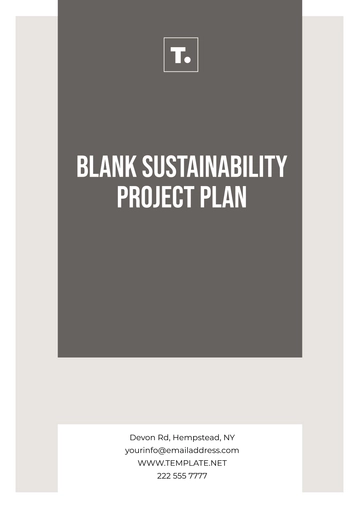Free Non-Profit Sustainability Plan

Date: [Date]
Prepared By: [Your Name]
I. Executive Summary
Hope for Tomorrow is committed to providing high-quality educational resources to children in underserved communities. This Sustainability Plan outlines strategies to ensure the long-term financial stability, growth, and impact of our organization. By diversifying revenue sources, enhancing organizational capacity, and strengthening community partnerships, we aim to achieve our mission of empowering youth through education.
II. Purpose
The purpose of this plan is to:
Secure diverse and sustainable funding.
Strengthen internal operations and organizational capacity.
Ensure the long-term success of our educational programs.
Align financial strategies with our mission of providing equal access to education for all children, regardless of socioeconomic status.
III. Organizational Overview
Mission Statement: Hope for Tomorrow aims to provide educational resources, tutoring, and mentorship to children in low-income communities, empowering them to succeed in their academic and personal lives.
Programs and Services:
Tutoring Services: After-school tutoring programs for math, reading, and science.
Mentorship: One-on-one mentoring to guide children through academic and personal challenges.
Summer Learning Camps: Educational camps during the summer to prevent learning loss.
Key Stakeholders:
Donors: Individuals, foundations, and corporate partners.
Volunteers: Tutors, mentors, and camp counselors.
Community Partners: Local schools, libraries, and other non-profits.
IV. Goals and Objectives
Goal 1: Diversify revenue streams to ensure financial sustainability.
Objective 1.1: Secure at least three new corporate sponsors each year to fund our tutoring programs.
Objective 1.2: Increase individual donations by 20% over the next two years through targeted fundraising campaigns.
Objective 1.3: Launch a social enterprise by opening a used book store to generate consistent revenue.
Goal 2: Enhance organizational capacity to effectively deliver programs.
Objective 2.1: Increase staff training and development opportunities to improve program delivery and staff retention.
Objective 2.2: Invest in a new donor management system to streamline fundraising efforts and donor relations.
Objective 2.3: Expand the board of directors to include professionals with expertise in fundraising, education, and nonprofit governance.
Goal 3: Strengthen community partnerships and networks.
Objective 3.1: Partner with at least two local schools to integrate tutoring services into their after-school programs.
Objective 3.2: Foster stronger relationships with local businesses for volunteer and donation support.
V. Financial Sustainability
Revenue Diversification:
Grants: Pursue grants from government agencies and private foundations that align with our mission.
Corporate Sponsorships: Establish long-term partnerships with businesses to fund specific programs.
Individual Donations: Increase engagement with current and new donors through personalized communication and events.
Social Enterprise: Open a second-hand bookstore, with proceeds going directly to funding tutoring services.
Financial Management:
Maintain an emergency fund equal to three months of operational costs.
Conduct regular financial audits and transparency reports.
Create a clear budget with specific allocations for each program area.
VI. Program Sustainability
Program Evaluation:
Conduct bi-annual surveys of students, parents, and teachers to assess the effectiveness of our tutoring and mentorship programs.
Use feedback to refine and improve program offerings.
Scalability and Replicability:
Develop a mentorship and tutoring training manual that can be used in other communities.
Establish a model for the summer learning camps that can be replicated in neighboring towns.
Impact Measurement:
Track student academic progress and compare it with baseline data.
Measure the number of students who progress to the next grade level or demonstrate improved academic skills.
VII. Organizational Sustainability
Leadership Development:
Provide quarterly leadership training for senior staff and board members to improve management and governance skills.
Develop a leadership pipeline for emerging leaders within the organization.
Staff and Volunteer Engagement:
Implement a volunteer recognition program to acknowledge the contributions of tutors, mentors, and counselors.
Provide professional development opportunities for staff to enhance program effectiveness.
Succession Planning:
Identify key roles within the organization and create a succession plan to ensure leadership continuity in case of turnover.
VIII. Community and Stakeholder Engagement
Partnerships and Collaborations:
Establish a formal partnership with the local school district to integrate our programs into their academic initiatives.
Collaborate with other non-profits in the community to share resources and increase impact.
Volunteer Engagement:
Develop a robust volunteer recruitment campaign through local colleges, businesses, and social media.
Create volunteer recognition events and offer development opportunities to keep volunteers engaged.
Donor Stewardship:
Implement a donor stewardship program that includes regular updates, recognition events, and opportunities for direct involvement in programs.
IX. Risk Management
Risk Assessment:
Financial Risk: Dependence on a small number of large donors.
Program Risk: Changes in local school policies that may limit access to students.
Reputational Risk: Negative publicity from program failure or operational mismanagement.
Mitigation Strategies:
Develop a diversified funding strategy to reduce reliance on a few major donors.
Create contingency plans for program delivery, including virtual tutoring options.
Implement a proactive public relations plan to manage and mitigate potential crises.
X. Monitoring and Evaluation
Evaluation Plan:
Track progress against goals using key performance indicators (KPIs) such as funding growth, program impact, and volunteer retention.
Conduct annual reviews of the Sustainability Plan to make necessary adjustments based on outcomes and challenges.
KPIs:
Increased number of students served.
Year-over-year growth in funding sources.
Positive feedback from program beneficiaries.
Review Cycle:
Review this plan annually with the board and senior management team, adjusting as needed to meet changing needs and circumstances.
XI. Conclusion
This Sustainability Plan serves as a guide for Hope for Tomorrow to achieve long-term success and ensure that we can continue to provide critical educational resources to children in underserved communities. With a diversified revenue stream, strong organizational capacity, and strong community engagement, we are well-positioned to make a lasting impact.
- 100% Customizable, free editor
- Access 1 Million+ Templates, photo’s & graphics
- Download or share as a template
- Click and replace photos, graphics, text, backgrounds
- Resize, crop, AI write & more
- Access advanced editor
Create a long-term strategy for your non-profit's growth and impact with the Non-Profit Sustainability Plan Template, offered by Template.net. This customizable and downloadable template is designed to help you establish a solid foundation for your organization’s future. It is fully editable in our AI Editor Tool, allowing for easy modifications to fit your specific goals. Plus, it’s printable for convenient physical copies, making it perfect for team collaboration and presentations. Start planning your non-profit’s sustainable future today!
You may also like
- Finance Plan
- Construction Plan
- Sales Plan
- Development Plan
- Career Plan
- Budget Plan
- HR Plan
- Education Plan
- Transition Plan
- Work Plan
- Training Plan
- Communication Plan
- Operation Plan
- Health And Safety Plan
- Strategy Plan
- Professional Development Plan
- Advertising Plan
- Risk Management Plan
- Restaurant Plan
- School Plan
- Nursing Home Patient Care Plan
- Nursing Care Plan
- Plan Event
- Startup Plan
- Social Media Plan
- Staffing Plan
- Annual Plan
- Content Plan
- Payment Plan
- Implementation Plan
- Hotel Plan
- Workout Plan
- Accounting Plan
- Campaign Plan
- Essay Plan
- 30 60 90 Day Plan
- Research Plan
- Recruitment Plan
- 90 Day Plan
- Quarterly Plan
- Emergency Plan
- 5 Year Plan
- Gym Plan
- Personal Plan
- IT and Software Plan
- Treatment Plan
- Real Estate Plan
- Law Firm Plan
- Healthcare Plan
- Improvement Plan
- Media Plan
- 5 Year Business Plan
- Learning Plan
- Marketing Campaign Plan
- Travel Agency Plan
- Cleaning Services Plan
- Interior Design Plan
- Performance Plan
- PR Plan
- Birth Plan
- Life Plan
- SEO Plan
- Disaster Recovery Plan
- Continuity Plan
- Launch Plan
- Legal Plan
- Behavior Plan
- Performance Improvement Plan
- Salon Plan
- Security Plan
- Security Management Plan
- Employee Development Plan
- Quality Plan
- Service Improvement Plan
- Growth Plan
- Incident Response Plan
- Basketball Plan
- Emergency Action Plan
- Product Launch Plan
- Spa Plan
- Employee Training Plan
- Data Analysis Plan
- Employee Action Plan
- Territory Plan
- Audit Plan
- Classroom Plan
- Activity Plan
- Parenting Plan
- Care Plan
- Project Execution Plan
- Exercise Plan
- Internship Plan
- Software Development Plan
- Continuous Improvement Plan
- Leave Plan
- 90 Day Sales Plan
- Advertising Agency Plan
- Employee Transition Plan
- Smart Action Plan
- Workplace Safety Plan
- Behavior Change Plan
- Contingency Plan
- Continuity of Operations Plan
- Health Plan
- Quality Control Plan
- Self Plan
- Sports Development Plan
- Change Management Plan
- Ecommerce Plan
- Personal Financial Plan
- Process Improvement Plan
- 30-60-90 Day Sales Plan
- Crisis Management Plan
- Engagement Plan
- Execution Plan
- Pandemic Plan
- Quality Assurance Plan
- Service Continuity Plan
- Agile Project Plan
- Fundraising Plan
- Job Transition Plan
- Asset Maintenance Plan
- Maintenance Plan
- Software Test Plan
- Staff Training and Development Plan
- 3 Year Plan
- Brand Activation Plan
- Release Plan
- Resource Plan
- Risk Mitigation Plan
- Teacher Plan
- 30 60 90 Day Plan for New Manager
- Food Safety Plan
- Food Truck Plan
- Hiring Plan
- Quality Management Plan
- Wellness Plan
- Behavior Intervention Plan
- Bonus Plan
- Investment Plan
- Maternity Leave Plan
- Pandemic Response Plan
- Succession Planning
- Coaching Plan
- Configuration Management Plan
- Remote Work Plan
- Self Care Plan
- Teaching Plan
- 100-Day Plan
- HACCP Plan
- Student Plan
- Sustainability Plan
- 30 60 90 Day Plan for Interview
- Access Plan
- Site Specific Safety Plan





























